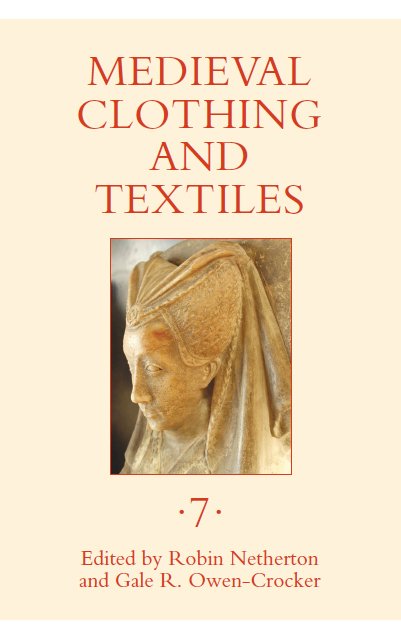Book contents
- Frontmatter
- Contents
- Illustrations
- Tables
- Contributors
- Preface
- The Empress’s New Clothes: A Rotulus Pannorum of Isabella, Sister of King Henry III, Bride of Emperor Frederick II
- Unveiling Social Fashion Patterns: A Case Study of Frilled Veils in the Low Countries (1200–1500)
- What Is the Pearl-Maiden Wearing, and Why?
- “Hys surcote was ouert”: The “Open Surcoat” in Late Medieval British Texts
- London Merchants’ Cloth Exports, 1350–1500
- Laboreria Sete: Design and Production of Lucchese Silks in the Late Fourteenth and Early Fifteenth Centuries
- Recent Books of Interest
- Contents of Previous Volumes
Unveiling Social Fashion Patterns: A Case Study of Frilled Veils in the Low Countries (1200–1500)
Published online by Cambridge University Press: 18 February 2023
- Frontmatter
- Contents
- Illustrations
- Tables
- Contributors
- Preface
- The Empress’s New Clothes: A Rotulus Pannorum of Isabella, Sister of King Henry III, Bride of Emperor Frederick II
- Unveiling Social Fashion Patterns: A Case Study of Frilled Veils in the Low Countries (1200–1500)
- What Is the Pearl-Maiden Wearing, and Why?
- “Hys surcote was ouert”: The “Open Surcoat” in Late Medieval British Texts
- London Merchants’ Cloth Exports, 1350–1500
- Laboreria Sete: Design and Production of Lucchese Silks in the Late Fourteenth and Early Fifteenth Centuries
- Recent Books of Interest
- Contents of Previous Volumes
Summary
Veils with frilled or ruffled edges have long been recognized as a fashionable accessory for upper-class women in some parts of Europe in the later Middle Ages. Until recently, however, it was generally believed frilled veils were very rare in the Low Countries. This study will make clear that the opposite is the case. Nearly 200 visual records of frilled veils—including paintings, sculptures, and figurative objects such as utensils and accessories—were collected from this region and subjected to statistical analysis. Written accounts mentioning frilled headdresses were examined as well. The morphological evolution and the social patterns in the development of this headdress style were studied using the seriation technique (described below). To my knowledge, this technique has not yet been used to extract social information from visual sources. This case study is designed to demonstrate the usefulness of such an approach.
Status Quaestionis of Frilled Headwear in the Low Countries
Research on the subject of frilled veils in the Low Countries has been very limited. Anne Liebreich’s conclusion, in her article of 1925 in the German journal Waffen-und Kostümkunde, is still widely accepted; she believed frilled headdresses in the Southern and Northern Netherlands were very rare, as opposed to their popularity in the other parts of the Holy Roman Empire. She was aware of only three Flemish visual sources for the frilled veil. Two are paintings by Jan van Eyck: the betrothal portrait of Giovanni Arnolfini and Giovanna Cenami (1434, National Gallery, London) and the portrait of Margareta van Eyck (1439, Groeningemuseum, Bruges). The third example is a scene of the birth of John the Baptist from the Turin-Milan Book of Hours. In 1928, Liebreich mentioned a fourth, a frilled veil depicted on the donatrix in a Ghent missal from 1366. Eveline Grönke and Edgar Weinlich referred to Liebreich’s work in 1998 when they wrote that the frilled veil did not appear in Flanders and Northern France.
In 1980, however, in her milestone book Fashion in the Age of the Black Prince, Stella Mary Newton had already briefly discussed frilled veils in her chapter on “National Traits and Deviations in the Dress of the Period.” She concluded that although the frilled veils were, apparently, not worn in France, they were in the Low Countries.
- Type
- Chapter
- Information
- Medieval Clothing and Textiles 7 , pp. 33 - 64Publisher: Boydell & BrewerPrint publication year: 2011



